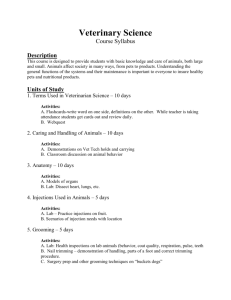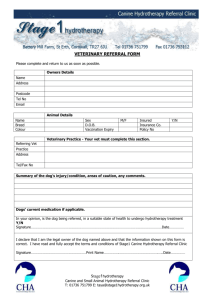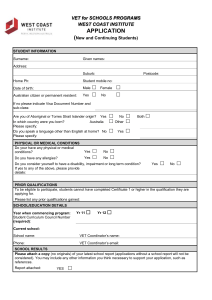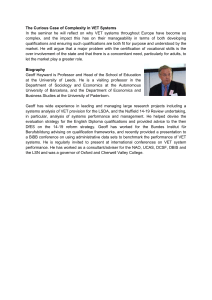University of the philippines COLLEGE OF VETERINARY MEDICINE
advertisement
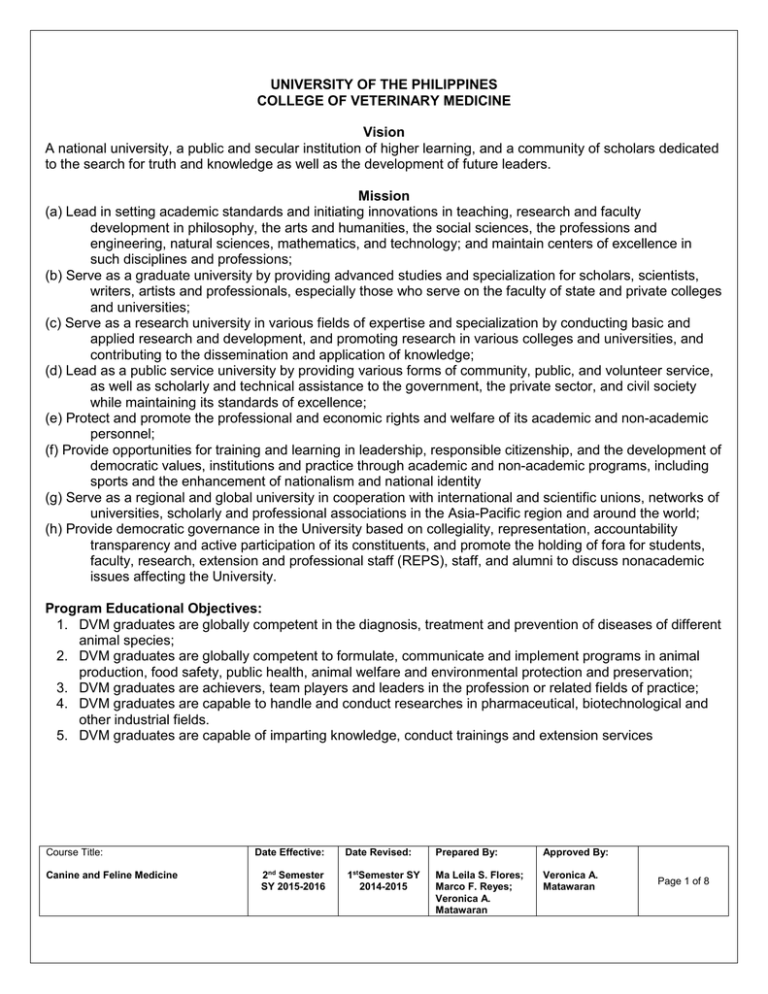
UNIVERSITY OF THE PHILIPPINES COLLEGE OF VETERINARY MEDICINE Vision A national university, a public and secular institution of higher learning, and a community of scholars dedicated to the search for truth and knowledge as well as the development of future leaders. Mission (a) Lead in setting academic standards and initiating innovations in teaching, research and faculty development in philosophy, the arts and humanities, the social sciences, the professions and engineering, natural sciences, mathematics, and technology; and maintain centers of excellence in such disciplines and professions; (b) Serve as a graduate university by providing advanced studies and specialization for scholars, scientists, writers, artists and professionals, especially those who serve on the faculty of state and private colleges and universities; (c) Serve as a research university in various fields of expertise and specialization by conducting basic and applied research and development, and promoting research in various colleges and universities, and contributing to the dissemination and application of knowledge; (d) Lead as a public service university by providing various forms of community, public, and volunteer service, as well as scholarly and technical assistance to the government, the private sector, and civil society while maintaining its standards of excellence; (e) Protect and promote the professional and economic rights and welfare of its academic and non-academic personnel; (f) Provide opportunities for training and learning in leadership, responsible citizenship, and the development of democratic values, institutions and practice through academic and non-academic programs, including sports and the enhancement of nationalism and national identity (g) Serve as a regional and global university in cooperation with international and scientific unions, networks of universities, scholarly and professional associations in the Asia-Pacific region and around the world; (h) Provide democratic governance in the University based on collegiality, representation, accountability transparency and active participation of its constituents, and promote the holding of fora for students, faculty, research, extension and professional staff (REPS), staff, and alumni to discuss nonacademic issues affecting the University. Program Educational Objectives: 1. DVM graduates are globally competent in the diagnosis, treatment and prevention of diseases of different animal species; 2. DVM graduates are globally competent to formulate, communicate and implement programs in animal production, food safety, public health, animal welfare and environmental protection and preservation; 3. DVM graduates are achievers, team players and leaders in the profession or related fields of practice; 4. DVM graduates are capable to handle and conduct researches in pharmaceutical, biotechnological and other industrial fields. 5. DVM graduates are capable of imparting knowledge, conduct trainings and extension services Course Title: Canine and Feline Medicine Date Effective: 2nd Semester SY 2015-2016 Date Revised: Prepared By: Approved By: 1stSemester SY 2014-2015 Ma Leila S. Flores; Marco F. Reyes; Veronica A. Matawaran Veronica A. Matawaran Page 1 of 8 COURSE GUIDE (OBE FORM) 1. Course Code: VMED 152 2. Course Title: CANINE AND FELINE MEDICINE 3. Prerequisite: VMED 151 4. Co-requisite: None 5. Credit: Schedule: 6. Description: 4 units Monday to Thursday (8:00 to 9:00 a.m.) Diagnosis and treatment of diseases of dogs and cats 7. Student Outcomes and Relationship to Program Educational Objectives Program/Student Outcomes 1 2 3 4 5 6 7 8 9 10 11 12 13 14 15 An ability to work effectively in multi-disciplinary and multi-cultural teams A recognition of professional, social and ethical responsibility An ability to effectively communicate orally and in writing using both English and Filipino An ability to engage in life-long learning and an understanding of the need to keep current of the developments in the specific field of practice An appreciation of Filipino historical and cultural heritage The ability to work independently and/or in teams of related fields with minimal supervision Identify and diagnose animal diseases and abnormalities Treat and manage diseased animals Formulate plans and implement programs for diagnosis, treatment, prevention, control and eradication of animal diseases Promote and implement animal welfare programs Plan, implement and monitor cost-effective programs in animal production Promote veterinary public and environmental health and biosecurity programs Conduct veterinary related researches Communicate effectively with entrepreneurial and ethical interpersonal skills in the practice of the profession The student should be able to qualify to practice the profession locally and internationally Program Educational Objectives 1 2 3 4 5 / / / / / / / / / / / / / / / / / / / / / / / / / / / / / / / / / / / 8. Course Outcomes (Cos) and Relationship to Student Outcomes Course Outcomes At the end of the course, the student shall be able to 4 Understand and create preventive health Course Title: Canine and Feline Medicine Date Effective: 2nd Semester SY 2015-2016 Program/student outcomes 1 2 3 4 5 6 7 8 9 10 11 12 13 14 15 / / / / / / / Date Revised: Prepared By: Approved By: 1stSemester SY 2014-2015 Ma Leila S. Flores; Marco F. Reyes; Veronica A. Matawaran Veronica A. Matawaran / / Page 2 of 8 program for small animals 2 Identify the clinical manifestations of common health disorders in dogs and cats 3 Determine the different measures necessary for the diagnosis, treatment, prevention and control of such disorders 1 And, identify common breeds of dogs and cats and their predilection for diseases REVERSE ORDER 9. Course Coverage Meeting Course Outcomes 1 / / / / / / / / / / / Topic / / / / / / Teaching Learning Activities (TLA) CO 1,4 *Vaccination for Dogs and Cats; Toy Dog Breeds 5-8 CO 1,2,3 *Polysystemic Problems Presentation Film/ Show Clip Flash cards Group Discussion 9-12 CO 2,3 *Hematolymphatic Problems Reporting 13-16 CO 2,3,4 *Neurologic and Behavioural Problems; Herding Dog Breeds Game Film Show 17 (Feb 24) 18-21 CO 2,3,4 *Urologic Problems; Cat breeds Case presentation 22-24 CO 2,3,4 *Reproductive Problems; Non-sporting Dog Breeds Case presentation 25-28 CO 2,3 **Cardiovascular Problems Clinical Practical Skills Recitation 29-32 CO 2,3 **Respiratory Problems Focus group discussion Recitation / / / / Assessment Task (AT) Breed Identification Exam 1 Patch work Exam 1 Quiz Exam 1 Patchwork texts Exam 1 First [Difficult] Exam 33 (Mar 25) 34-37 CO 1,2,3 ***Nutritional Problems Film showing 38-41 CO 2,3,4 ***Digestive Problems; Working Dog Breeds Trivial Pursuit Canine and Feline Medicine / Orientation 2-4 Course Title: / Case analysis Patchwork texts Exam 2 Case analysis Project Exam 2 Case-based care plan Patchwork texts Exam 2 Activity report Activity Report Exam 2 Second [Even Harder] Exam Date Effective: 2nd Semester SY 2015-2016 Date Revised: Prepared By: Approved By: 1stSemester SY 2014-2015 Ma Leila S. Flores; Marco F. Reyes; Veronica A. Matawaran Veronica A. Matawaran Question and Answer; Exam 3 Reaction Paper; Exam 3 Page 3 of 8 42-45 CO 2,3,4 ***Musculoskeletal Problems; Sporting Dog Breeds Game Quiz; Exam 3 46-49 CO 2,3,4 ***Conformational Problems; Terrier Dog Breeds Group discussion Discussion feedback; Exam 3 50 (Apr 28) 51-54 CO 2,3,4 ***Dermatologic Problems Show and Tell 55-58 CO 2,3,4 ***Special Sensation Problems; Hound Dog Breeds Debate Pictogram; Exam 4 Essay; Exam 4 59-62 CO 2,3,4 ****Small Animal Oncology Lecture/discussion; Recitation 63-65 CO 2,3 ****Laboratory-Defined Problems Lecture/discussion; Group case analysis 66 (May 26) Third [Tough] Exam Case Assignment; Exam 4 Case Analysis; Exam 4 Fourth [Last Chance to be Exempted] Exam REORDER TOPICS BASED ON REVISED COURSE OUTCOMES Lecturers: *MFR, **KRBG, ***MLSF, ****VAM 10. Lifelong learning opportunities Problem oriented medical approach to diagnosis and treatment is a way of thinking and eventually the skill developed in the students through the discourse of VMED 152. This will allow the student to perform veterinary medical and professional tasks with confidence and aplomb. 11. Contribution of course to meeting the professional component Veterinary Medicine Topics – 90% General Education – 10% 12. References: Barr SC and DD Bowman. (2006) The 5 Minute Vet Consult Clinical Companion Canine and Feline Infectious Disease and Parasitology, 1st ed. Bonagura JD and DC Twedt. (2009) Kirk’s Current Veterinary Therapy XIV Dobson JM and BDX Lascelles. (2003) Canine and Feline Oncology. London: British Small Animal Veterinary Association. Ettinger SJ and EC Feldman. (2010) Textbook of Veterinary Internal Medicine. 7th ed. (Vol I and II) Ford RB and EM Mazzaferro (2006). Kirk and Bistner’s Handbook of Veterinary Procedures and Emergency Treatment, 8th ed. Hall E, Murphy K and P Darke. (2003) Notes on Canine Internal Medicine. Course Title: Canine and Feline Medicine Date Effective: 2nd Semester SY 2015-2016 Date Revised: Prepared By: Approved By: 1stSemester SY 2014-2015 Ma Leila S. Flores; Marco F. Reyes; Veronica A. Matawaran Veronica A. Matawaran Page 4 of 8 Meuten D. Tumors in Domestic Animals. 2nd ed. Nelson RW and CG Couto. (2008) Small Animal Internal Medicine. 4th ed. Norsworthy GD, SF Grace, MA Crystal and LP Tilley. (2010) The Feline Patient (Essentials of diagnosis and treatment), 4th ed. Thrall MAN, G Weiser, RW Allison and TW Campbell (2012) Vet. Hematology and Clinical Chemistry, 2nd ed. 13. Course Evaluation Student performance will be rated based on the following: Assessment Tasks Points (720 total) First Examination Coverage Second Examination Coverage Third Examination Coverage Fourth Examination Coverage Examination 1 Breed identification Quiz Reaction paper Recitation Examination 2 – MFR’s part Case analysis Project Examination 2 – KRBG’s part Case based care plan Patchwork texts Activity Report Examination 3 Question and Answer Reaction Paper Quiz Discussion feedback Examination 4 – LSF’s part Pictogram Essay Examination 4 – VAM’s part Case analysis Case assignment TOTAL 100 20 20 20 20 50 20 20 45 15 15 15 100 20 20 20 20 50 20 20 50 20 20 720 Weight 13.88 % 2.78 % 2.78 % 2.78 % 2.78 % 6.94 % 2.78 % 2.78 % 6.25 % 2.08 % 2.08 % 2.08 % 13.88 % 2.78 % 2.78 % 2.78 % 2.78 % 6.94 % 2.78 % 2.78 % 6.94 % 2.78 % 2.78 % 100.00 % Minimum average for satisfactory performance 70.00 % 70.00 % 70.00 % 70.00 % 70.00 % 70.00 % 70.00 % 70.00 % 70.00 % 70.00 % 70.00 % 70.00 % 70.00 % 70.00 % 70.00 % 70.00 % 70.00 % 70.00 % 70.00 % 70.00 % 70.00 % 70.00 % 70.00 % 70.00 % The final grades will correspond to the weighted average scores shown below: Points Earned UP Grade 684 – 720 pts. 1.0 673 – 696 1.25 649 – 672 1.5 625 – 648 1.75 601 – 624 2.0 577 – 600 2.25 (exemption) Course Title: Canine and Feline Medicine Date Effective: 2nd Semester SY 2015-2016 Points Earned UP Grade 553 – 576 2.50 529 – 552 2.75 505 – 528 3.0 468 – 504 4.0 <467 5.0 Date Revised: Prepared By: Approved By: 1stSemester SY 2014-2015 Ma Leila S. Flores; Marco F. Reyes; Veronica A. Matawaran Veronica A. Matawaran Page 5 of 8 13.1. Other Course Policies a. Attendance Only officially registered students (with class cards) will be admitted in the class. Students without class cards will be marked absent. University rule on attendance will be enforced. Maximum number of absences is 6. Students with 7 or more unexcused absences will be dropped and given a grade of “5”. Student coming to class beyond the 10 min into the official class hour is considered absent. b. Submission of Assessment Tasks Learning tasks and other assigned works are to be submitted at the beginning of the class periods of the specified dates. Late assignments will have a corresponding deduction of points as deemed fit by the Professor. Email & fb group: for recitation/discussion, announcements, quizzes/exercises, handouts, lectures and queries. c. Written Examinations Points may be earned from quizzes, exams, recitation, and other sources, as determined by the faculty members. No electronic devices, food and leaving the room during quizzes and examinations. Final examination is 30% of the final grade of the course. d. Language of Instruction The course will be presented in a problem-oriented manner; while discussions about different dog and cat breeds will be incorporated where appropriate. Lectures, discussion and documentation will be in Filipino or English, whichever is more comfortable and easy to communicate for the speaker. However, the mixture of words from the two languages in one sentence is not encouraged. e. Honor, Dress and Grooming Codes Plagiarism and cheating are prohibited. Make proper citation where appropriate. Students not in complete proper vet med uniform will be marked absent. f. Consultation Schedule Consultation schedule of MLSFlores is every Tuesday and Thursday, 1:00 to 2:30 and 4:00 to 5:00 p.m. 14. Reading Assignments The following articles are required reading for this course. The number of pages per article is indicated after every count to ensure that the student will not miss any page. The student is encouraged to find and read other scholarly references related to the topics discussed in class. 1st Exam coverage: 1-(3pp) Day MJ. 2011. Vaccination of dogs and cats: no longer so controversial? Vet Rec V168: 480-482. Doi: 10.1136/vr.d2810 2-(8pp) Bruchim Y, E Loeb, J Saragusty and I Aroch. 2009. Pathological findings in dogs with fatal heatstroke. J Compar Patho. V140: 91-104. 3-(5pp) Chervier C, L Chabanne, M Godde, MI Rodriguez-Pineiro, BL Deputte and JL Cadore. 2012. Causes, diagnostic signs, and the utility Course Title: Canine and Feline Medicine Date Effective: 2nd Semester SY 2015-2016 19-(9pp) Foster S. 2004. Lower respiratory tract infections in dogs and cats. PGFVSc Proc. V354: 349-357. 20-(11pp) Nykamp SG, PV Scrivani and NL Dykes. 2002. Radiographic Signs of Pulmonary Disease: An Alternative Approach. Compend on Cont Educ PracticVeteri 24(1): 25-35. 21-(6pp) Padrid P. 1999. Feline asthma: pathophysiology and treatment. Walth Focus 9:17-22. Date Revised: Prepared By: Approved By: 1stSemester SY 2014-2015 Ma Leila S. Flores; Marco F. Reyes; Veronica A. Matawaran Veronica A. Matawaran Page 6 of 8 of investigations of fever in dogs: 50 cases. Canad Vet J. V53: 525-530 4-(7pp) Mattoso CRS, RK Takahira, SL Beier, KP Araujo Jr. And KE Corrente. 2010. Prevalence of von Willebrand disease in dogs from Sao Paulo State, Brazil. J Vet Diagn Investig 22: 55-60. Doi: 10.1177/104063871002200109 5-(7pp) Moore FM, WE Emerson, SM Cotter and RA DeLellis. 1986. Distinctive peripheral lymph node hyperplasia of young cats. Vet Pathol Online. 23: 386-391. DOI: 10.1177/030098588602300407 6-(3pp) Lobetti RG and P Caldwell. 2012. Doramectin toxicity in a group of lions (Panthera leo). J South Afr Vet Assoc 83 (1), Art. #509. dx.doi. org/10.4102/jsava.v83i1.509 7-(8pp) Kralova S, L Leva and M Toman. 2009. Polymorphonuclear function in naturally occurring renal failure in dogs. Vet Med 54 (5): 236243. 8-(3pp) Samal L, AK Pattanaik, C Mishra, BR Maharana, LN Sarangi and RK Baithalu. 2011. Nutritional strategies (sic) to prevent urolithiasis in animals. Vet World 4(3): 142-144. 9-(2pp) Lulich JP and CA Osborne. 2012.Urolithiasis: past, present and future. J Small Anim Pract. V53: 621-622. 2nd Exam coverage: 10-(4pp) Kralova-Kovarikova, R Husnik, D Honzak, P Kohout and P Fictum. 2012. Stenotrophomonas maltophilia urinary tract infections in three dogs: a case report. Vet Med 57 (7): 380-383. 11-(10pp) Santiago-Flores ML, MC Jaro, FC Recuenco, MF Reyes and MRG Amparo. 2012. Clinical profile of canine transmissible venereal tumor cases. Philip J Vet Anim Sci 38(1): 63-72. 12-(11pp) Gompf RE. 1991. The significance of gallop rhythms and arrhythmias. In Consultations in Feline Int Med. Ed. Chapter 26: 213223. 13-(15pp) Knight DH. 1991. Efficacy of inotropic support of the failing heart. Vet Clin N Am. Pp 879-904. 14-(11pp) Sisson DS. 1991. Evidence for or against the efficacy of afterload reducers for management of heart failure in dogs. Vet Clin of N Am. pp 945-955 15-(6pp) French A, VL Fuentes, J Dukes-McEwan, PGG Darke, M Martin and B Corcoran. 2000. Progression of aortic stenosis in the boxer. J Sm Anim Pract, 41:451-456. doi: 10.1111/j.17485827.2000.tb03140.x 16-(11pp) Bulmer BJ. 2006. Performing a cardiovascular physical examination. Vet Med 101 (1): 37-47. 17-(14pp) Hamlin RL. 1991. Evidence for or against clinical efficacy of preload reducers. Vet Clin N Amer. Pp 931-944. 22-(5pp) Walker AL, SS Jang, and DC Hirsh. 2000. Bacteria associated with pyothorax of dogs and cats: 98 cases (1989-1998). J Ame Vet Med Assoc 216:359-363. 3rd Exam coverage: 23-(5pp) Chandler M. 2010. Vomiting in dogs and cats – is it medical or surgical? In Pract 32: 82-89 doi: 10.1136/inp.c746 24-(6pp) Grellet A, S Chastant-Maillard, C Robin, et al. 2014. Risk factors of weaning diarrhea in puppies housed in breeding kennels. Prevent Vet Med 117:260-265. 25-(10pp) Tefft KM. 2014. Successful management strategies for canine parvovirus. Paper presented to the Indi Vet Med Assoc Annu Mtg. 26-(13pp) Sykes JE, K Hartmann, KF Lunn, et al. 2011. 2010 ACVIM small animal consensus statement on leptospirosis: diagnosis, epidemiology, treatment and prevention. J Vet Intern Med 25: 1-13. 4th Exam coverage: 27-(7pp) Nuttal T, M Uri and R Halliwell. 2013. Canine atopic dermatitis – what have we learned? Vet Rec 172: 201-207. doi: 10.1136/vr.f1134 28-(11pp) Mueller RS, E Besignor, L Ferrer et al. 2012. Treatment of demodicosis in dogs: 2011 clinical practice guidelines. Vet Dermatol 23: 86-e21. 29-(4pp) Singh SK, M Kumar, RK Jadhav and SK Saxena. 2011. An update on therapeutic management of canine demodicosis. Vet World 4(1): 41-44. 30-(5pp) Moriello KA. 2004. Treatment of dermatophytosis in dogs and cats: review of published studies. Vet Dermatol 15: 99-107. 31-(14pp) Ural K, H Voyvoda, B Ulutas et al. 2012. Understanding primary and secondary skin lesions among infectious dermatoses in dogs: lessons we learned from cases. Anim Health, Prod and Hygiene 1(2): 86-99. 32-(3pp) Mueller RS, SV Bettenay and M Shipstone. 2001. Value of the pinnal-pedal reflex in the diagnosis of canine scabies. Vet Rec. 148: 621-623. 33- Section VI. Clinical Case Presentations (selected cases) in Thrall, MAN, G Weiser, RW Allison and TW Campbell. 2012. Vet Hematol and Clin Chem, 2nd ed., pp 615-749 34-Chapters 25 to 26. In Thrall, MAN, G Weiser, RW Allison and TW Campbell. 2012. Vet Hematol and Clin Chem, 2nd ed. 35-Chapters 1,3,5,6,8,9. In Dobson JM and BDX Lascelles. 2003. Canine and Feline Oncology, 2nd ed. England: British Small Animal Vet Assoc. 18-(3pp) Lombard CW, Jons O & Bussadori CM. 2006. Clinical Efficacy of Pimobendan Versus Benazepril for the Treatment of Acquired atrioventricular valvular disease in dogs. J Amer Anim Hosp Assoc V42: 249-261. 15. Course Materials Course Title: Canine and Feline Medicine Date Effective: 2nd Semester SY 2015-2016 Date Revised: Prepared By: Approved By: 1stSemester SY 2014-2015 Ma Leila S. Flores; Marco F. Reyes; Veronica A. Matawaran Veronica A. Matawaran Page 7 of 8 Course Syllabus Reading Materials 16. VMED 152 Professors: Veronica A. Matawaran (vamatawaran@yahoo.com); Karlo R. B. Gicana (karlo_gicana@yahoo.com) Marco F. Reyes (marcofreyes@yahoo.com); M. Leila S. Flores (leiladvm@yahoo.com) [coordinator] Department of Veterinary Clinical Sciences, College of Veterinary Medicine, UPLB Tel: (049)536-6901 Facebook account: Mls Flores 17. CQI Remarks The student must get at least a grade of 70% to pass the Course. Course Title: Canine and Feline Medicine Date Effective: 2nd Semester SY 2015-2016 Date Revised: Prepared By: Approved By: 1stSemester SY 2014-2015 Ma Leila S. Flores; Marco F. Reyes; Veronica A. Matawaran Veronica A. Matawaran Page 8 of 8



